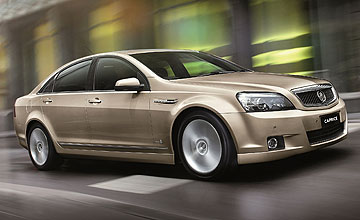BY RON HAMMERTON | 22nd Feb 2012

The company said its customers had spoken loud and clear about the need for a large car with a small-car’s environmental credentials and fuel savings, preferring “dough over go”.
It said it built prototypes with both liquid- and vapour-injection in the early stages of the two-year development project and found that the new-generation vapour system it developed better met it goals, particularly in fuel economy and CO2 emissions.
The result is a 3.6-litre V6 LPG Commodore large sedan that produces just 189 grams of carbon dioxide per kilometre – the best of any locally built large car and better than many four-cylinder medium cars – but with 30kW less power than its 210kW petrol equivalent.
And while the new LPG Commodore is greener than Ford’s equivalent new LPG-powered Falcon EcoLPi, which emits 199g/km of CO2 in its base 4.0-litre XT guise, the big Ford churns out 198kW of power and 409Nm of torque – 18kW and 89Nm more respectively than the 180kw/320Nm gas-propelled Holden.
The new Holden LPG system – largely engineered in-house with a bunch of freshly minted patents to prove it – replaces the old dual-fuel petrol-LPG system available only on the fleet-friendly Commodore Omega and Berlina.
Now, Holden’s first dedicated gas system since it introduced the fuel to its local range as an option to petrol almost 20 years ago is available across the range - in Commodore sedan, Sportwagon, Ute and even long-wheelbase Caprice luxury sedan guises - at a $2500 premium.
This brings the price of the entry-level Commodore Omega to $42,490 - $100 more than the old dual-fuel LPG version.
With the current $2000 federal government rebate for private LPG car buyers, the cost premium comes down to $500 over the standard $39,990 petrol Commodore Omega.
Apart from slightly more power and torque (5kW/2Nm) than the previous LPG unit, the new LPG Commodore gets 13 per cent greater fuel economy, at 11.8 litres per 100km on the combined cycle.
This not only helps the Commodore to qualify as a four-and-a half star car on the federal government’s Green Vehicle Guide – an important sale consideration for many fleet buyers – but also cost as little as $1227 to refuel over 12 months – less than a Toyota Camry Hybrid ($1644) and $800 less than a 1.8-litre Toyota Corolla, Holden claims.
As well, the system is said to produce so few toxic emissions such as NOx and particulates that it qualifies for ‘Beyond Euro 6’ standards, making it capable of exceeding the most stringent exhaust standards yet conceived in Europe.
In another Holden first, the new LPG range uses lighter and locally developed aluminium gas tanks – two cylinders side by side under the boot with a combined capacity of 84 litres – instead of the traditional steel.
Holden claims it put the tanks through extensive rear-end crash testing – both simulated and real – to test the safety of the tanks and make sure of their integrity in severe situations, even though they are mounted behind the rear axle instead of in front, like the conventional petrol tanks.
Holden says the positioning of the tanks was governed by their size, which required the engineers to delete the usual spare tyre in the boot floor.
Instead, LPG Holden buyers will be given a puncture repair kit, or they can opt for an optional space-saver spare wheel if they don’t mind giving up a sizeable chunk of their boot space.
The big advantage of the under-floor tank mounting is that it can be applied to all local body styles, including Sportwagon and Ute, without the intrusive tank in the cargo area.
One of the biggest gains of the new LPG Commodore over its predecessor is the adoption – finally – of the six-speed automatic transmission that is standard on Holden’s petrol models.
This replaces the dual-fuel Commodore’s clunky old four-speeder that dates back to the previous generation VT Commodore with its push-rod Buick 3.8-litre V6.
The new automatic transmission is credited with helping to improve fuel economy because it is lighter and more efficient than the unit it replaces.
The switch to LPG required numerous changes to the engine and related systems, including new high-compression (12.0:1) pistons to make full use of the high (100-110 RON) fuel rating, hardened valves and valve seats to cope with the abrasive fuel, and a completely new exhaust system with twin underfloor mufflers and a single tailpipe.
The injectors and fuel rails were designed specifically for the engine, as was a new-design fuel vapouriser that uses electricity to warm the fuel to ensure quick cold-starts, before switching to warmth from engine coolant.
Holden says one of the biggest factors in achieving its fuel economy and emissions targets was the electronic management system, which was locally calibrated.
Holden chairman and managing director Mike Devereux said the dedicated LPG Commodore range was another example of Holden’s continued focus on making cars that suited modern Australia and the next step in the evolution of the VE Commodore.
“We are offering sophisticated motoring solutions to our customers,” he said. “The LPG Commodore range is a no-compromise prospect.
“With outstanding fuel consumption and CO2 emissions, cheaper fuel running costs than many small petrol cars and excellent driving characteristics, our customers will be able to enjoy the practicality and comfort of a large car without the large-car fuel bills.
“We are committed to taking a leadership position with alternative fuels to make sure Commodore remains the smart vehicle choice for Australian motorists.”
To launch the new LPG powertran, Holden is offering it free on the $61,990 Caprice – and buyers can still claim the $2000 federal rebate – and a fresh edition of Holden’s periodic Equipe limited-edition Commodore.
The latter comes with 18-inch alloys wheels, a rear-view camera, rear parking sensors, leather seat and steering wheel trim and foglights with chrome accents.